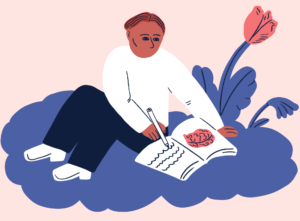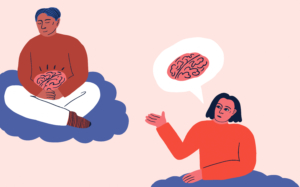Mindfulness has become an increasingly common feature in the life of stressed students. What kind of relationship do the students of Lund have to this ambiguous concept, and is the sudden popularity all that unproblematic?
“Have you ever biked somewhere, and suddenly you’ve arrived at your destination, but you have no recollection of how you got there? It happens to me all the time”.
The story of Student Health Centre psychologist Ulrika Linse Strömland’s almost forgotten bike rides is highly relatable. She talks about the phrase ‘autopilot’ and how we humans often go through our lives without being mindful of what we are doing.
Ulrika Linse Strömland has worked at the Student Health Centre for eleven years. Lately, she has noticed a growing interest in mindfulness and meditation amongst students. She believes that stress plays a big part in the increased curiosity.
“Many come to the Student Health Centre due to stress-related issues that are not necessarily due to them having too much to do, but rather because of their unhelpful thought patterns. We know that, according to science, these types of issues can be relieved by a regular practice of mindfulness”, says Ulrika Linse Strömland.

Noëmi Liebe has studied Medicine in Lund for three years. This autumn semester, she has taken a break to study History of Ideas. After sporadically using different mindfulness apps to help her calm down when feeling stressed, she realized that she wanted to explore the topic further.
“I had a period when I was very stressed and was looking for a way to cope with it. I started to think about taking a course in mindfulness to learn more than you can from just an app”, says Noëmi Liebe.
According to Ulrika Linse Strömland, mindfulness is the practice of consciously and open-mindedly focusing on the present, often by concentrating on your breathing. A few years ago, she decided to create a five-week long course where students could try out mindfulness at the Student Health Centre.
“The course is an example of what mindfulness is and can be. Like a smorgasbord of experiences where we go through different exercises and important topics”, says Ulrika Linse Strömland.
It created an internal conflict for me, where I still had my ambitions but found it difficult to exercise discipline and just sit at home and study.
Noëmi Liebe felt a need for, as well as an interest in, exploring mindfulness, which made her apply to the course.
“It was partly a necessity to be able to handle stress, but also a curiosity about what you can learn about life and yourself through mindfulness”, she says.
To her, mindfulness is largely about gaining a new perspective on life and working preventatively. She claims that it is especially important as a student of medicine given that female doctors have a high risk of burn-out.
“It is a concern I carry with me, that I need to prevent burn-out and take care of my mental health.”
During the pandemic many people, not least the students, had to change their everyday routines. Jon Liander Ankarcrona, an architecture student, is one of the people in the group. The effect the quarantine had on his mental health led him to try out mindfulness.
“I was not in a good place mentally during the pandemic. It created an internal conflict for me, where I still had my ambitions but found it difficult to exercise discipline and just sit at home and study”, he says.
It is a large part of my ambition to become a better human being and get better at relating to others.
He decided to create a new routine, one not dependent on or affected by the pandemic. He started journaling every morning, something he still does to this day.
“Sometimes my head feels like it is full of a muddle of thoughts. To get them down on paper feels like organizing your thoughts and clearing up some of the muddle at the same time. You get some perspective on your own thoughts”, and they feel more tangible when written down.
According to Jon Liander Ankarcrona, mindfulness has helped him become more aware of both himself and his surroundings.
“It is a large part of my ambition to become a better human being and get better at relating to others. The most important thing to me is being able to understand myself and what affects me, whether it be positively and negatively. I usually call it self-studies in wellbeing”, he says.
As mindfulness is a phrase used in several different contexts and cultures, it can be difficult to define what it actually entails. Katarina Plank, docent in religious studies, has done research on the topic; especially on its conceptualization in commercial and religious contexts.
“It can mean many different things and is dependent on the context in which mindfulness is practiced and interpreted. When it comes to such a fluid concept, it is important to be conscious of the fact that we might not always be speaking of the same thing, despite using the same phrase”, says Katarina Plank.
We need to presume that people find some sort of meaning in it.
She says that mindfulness, or meditation as it is most often referred to within Buddhism, is either integrated or separated. Within Buddhist tradition meditation is embedded in a cultural context that cannot be parted from the so-called ‘mental discipline’ of mindfulness. On the other hand, it has been separated from its original context and placed in a new one in the West.
“Trying to make the concept more abstract and remove it from its context, and claim that awareness or concentration is the core of it all makes mindfulness something else entirely”, she says.
After practicing meditation and attending different Buddhist meditation groups herself, it became obvious for Plank how big of a difference there is between the religious and secular interpretations of mindfulness and how it is practiced.
“That is why it is important to understand that mindfulness can be many different things, and that one is not necessarily more right or wrong than the other. We need to presume that people find some sort of meaning in it”, says Katarina Plank.
Lund Zen Centre is located in the heart of Lund. I walk through a door on a lively pedestrian street and, suddenly, all the noise disappears. On my way to the Centre, I pass through tunnel after tunnel and courtyard after courtyard. When I finally arrive at the entrance, I am welcomed by Zen Buddhist Richard Langlais. He describes the walk from the street outside as being similar to growing into your senses.
Zen is a term for nothing. It has no meaning; it is beyond words.
Richard Langlais is a zendo-teacher at the Centre. Zendo is the name of the meditation room. He explains that within Zen, a branch of Buddhism with roots in China, there is a lot of focus on meditation and being aware of your senses.
“Meditation is everything within Zen. But meditation does not have to be sitting on a mat in a meditation room, it can be a state you’re in every single day.”
Just like with mindfulness, it is difficult for Richard Langlais to fully explain what Zen is. He describes it as a method, rather than a belief. A method that entails practice in understanding and conquering your own consciousness. At the same time, he says that none of what he is saying is Zen.
“Zen is a term for nothing. It has no meaning; it is beyond words.”
At the Centre, they run meditation courses where people from different countries, religions, and backgrounds participate. It could be anyone from a student to a psychologist. Richard Langlais says that the members all have different relationships with Zen Buddhism, but that they all come together at the Centre.
“It is as diverse as Lund University. Some people are only here because they are attracted by the Japanese aesthetics of Zen. Then there are those who only come here for the meditation, and those who are involved in the Buddhist faith. It creates a nice community”, he says.
Langlais also believes that mindfulness is a dubious term that is used in many different contexts. He describes it as being as diverse as the inner workings of human beings. But as long as it makes people feel good, he thinks the use of mindfulness is positive.
“I see no problem with it if it isn’t hurtful or has any negative effects. It is only welcome that is reaches more people and is made into a thing of its own”, says Richard Langlais.
What this means is that if you were to fail the courses, it is your fault. It is a very cynical way to approach people who are already stressed.
From a health-perspective, Ulrika Linse Strömland believes there is a certain problem with the growing popularity of mindfulness. She says that the popularity of the phrase means that it risks being used too much and interpreted as something which claims to work as a universal solution.
“I feel like the concept of mindfulness has become a bit depleted and trivialised. It is being used everywhere as some sort of ‘universal solution’”, she says.

Since mindfulness entered Western society there has been, and still is, an outspoken critique toward its commercialization. Anne-Christine Hornborg, professor emerita in History of Religions, is rather critical against the companies who offer tools and exercises to make people feel better, whilst simultaneously relieving themselves of any responsibility and claiming that it is up to the individual to succeed.
“What this means is that if you were to fail the courses, it is your fault. It is a very cynical way to approach people who are already stressed. If the course does not make them feel better and they are unable to find their inner strength and capability, then they will get even more stressed – now they are both stressed and incompetent”, says Anne-Christine Hornborg.
The effect that mindfulness can have on both mind and body has interested many researchers. The majority of research agrees that meditation and mindfulness can decrease stress hormones and can be used to manage stress and anxiety. For example, some studies have shown that the practice of mindfulness in a group setting has especially positive effects on depression and anxiety, and that it can be as effective as cognitive behavioural therapy (CBT). However, despite these results it is still uncertain what actually happens when our brains are exposed to consistent meditation.
To experience the everyday as it is, both the good and the bad.
Being able to explore mindfulness together with other students in the course held by the Student Health Centre has meant a lot to Noëmi Liebe.
“It is beneficial to hear about other people’s experiences and know that I am not the only one who finds it difficult. When you’re on your own it’s easy to feel silly, but when you do it as a group it feels like we’re all in this together”, says Noëmi Liebe.
Even though she has only attended the course for a month Noëmi Liebe feel like it has already given her important lessons about life and herself.
“It is not about being enlightened or just sitting and breathing, it’s a life lesson. To experience the everyday as it is, both the good and the bad. And being able to adapt to it.”
Apart from actual relaxation practices, she has been taught exercises on how to be more present in everyday life and when doing everyday activities such as brushing your teeth, and being mindful of what you are doing, thinking, and feeling.
“I found it quite funny at first, because it felt ridiculous to overanalyse how it felt to brush my teeth. However, it was actually interesting to realise what I noticed when I was aware of what I was doing, and I realized how many things we do on autopilot”, says Noëmi Liebe.
It is essential to practice noticing the little things in life, like that hug you got. To stop for a moment and pay attention to when you are feeling good.
Ulrika Linse Strömland says that it is not only important to increase your awareness of how you are feeling and what is unprofitable for you. Bringing attention to positive things as well is just as important.
“It is essential to practice noticing the little things in life, like that hug you got. To stop for a moment and pay attention to when you are feeling good, instead of constantly being on a forward trajectory.”
This article was originally published in Swedish in Lundagård issue 7 2021
Translation: Elsa Wallerö









